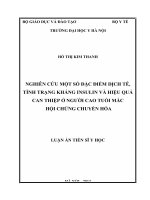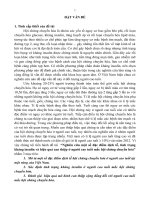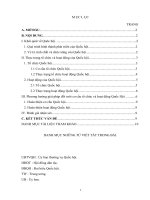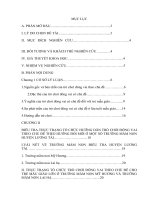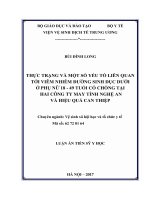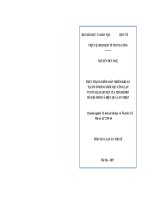Thực trạng tổ chức và quy trình hoạt động của hội đồng đạo đức trong nghiên cứu y sinh học cấp cơ sở và hiệu quả can thiệp TT TIENG ANH
Bạn đang xem bản rút gọn của tài liệu. Xem và tải ngay bản đầy đủ của tài liệu tại đây (354.44 KB, 28 trang )
MINISTRY OF EDUCATION
AND TRAINING
MINISTRY OF HEALTH
NATIONAL INSTITUTE OF HYGIENE & EPIDEMIOLOGY
HOANG HOA SON
THE CURRENT STATE OF ORGANIZATION AND
OPERATION OF THE INSTITUTIONAL REVIEW
BOARD AND THE EFFECTIVENESS OF
INTERVENTION
Speciality: Sociological Hygiene and Health Organization
Code: 62.72.01.64
SUMMARY OF PhD THESIS ON MEDICINE
HANOI – 2021
THIS RESEARCH IS COMPLETED AT THE NATIONAL
INSTITUTE OF HYGIENE AND EPIDEMIOLOGY
Scientific Supervisors:
1. Associate Professor Doctor Nguyen Thi Kim Tien
2. Professor Doctor Phan Thi Nga
Counter
arguer 1:
.............................................................
.............................................................
Counter
arguer 2:
.............................................................
.............................................................
Counter
arguer 3:
.............................................................
.............................................................
The doctoral thesis will be defended at the Dissertation
Committee of Institutional level at: National Institute of Hygiene
& Epidemiology.
At …, …. 2021.
The doctoral thesis can be found at:
1. The National Library of Vietnam
2. The Library of the National Institute of Hygiene and
Epidemiology
1
THESIS INTRODUCTION
Nowadays, there are more and more studies related to human
beings as subjects are conducted. Therefore, protecting the safety,
health and rights of research subjects – human beings - have become
an international requirement for biomedical studies. According to the
regulations, all institutional-level studies of biomedical on human
subjects must be evaluated by the Institutional Review Board called
IRB. Therefore, we do the research "The current state of
organization and operation of IRB and the effectiveness of the
intervention” with the two following objectives:
1. Describe the organizational status and operational
processes of IRBs, 2015.
2. Evaluation of the effectiveness of interventions to
improve the quality of operations of some IRBs, 2016–2018.
New points about science and practical value of the topic
1. Description of the current state of organization and
operation of IRB in Vietnam in 2015.
2. Assessment of the effectiveness of tools used by IRB in
evaluating research proposals in Vietnam till 2015.
3. Recommendations
on
additional
regulations,
implementation guidance and control as well as the construction
of forms for assessment tools, written notices of decisions to
IRBs from 2016 onwards.
The study identified the overall IRBs met the requirement of
member number. However, the quality assurance criteria of IRB
members are not fully guaranteed. In addition, there is no
2
consensus in the use of the tool for evaluating the research
proposal between different IRBs in Vietnam.
THE STRUCTURE OF THE THESIS
The thesis consists of 129 pages, 31 tables, 7 figures.
Introduction: 2 pages. Overview: 35 pages; Research subjects
and method: 18 pages; Results: 31 pages; Discussion: 40 pages;
Conclusion: 2 pages and Recommendation: 1 page.
Chapter 1
OVERVIEW
1.1. A number of basic concepts related to the topic
1.1.1. The general concept of ethics in biomedical research
Ethics in biomedical research is the principles, ethical norms
applied in biomedical studies related to research subjects of human
beings. Ethics in research not only matters at the stage of approval
of research proposals but also principles, ethical norms need to be
complied with in all phases of research from design, conduct,
supervision, inspection, processing, analysis and analysis of data.
1.1.2. History of regulations formation on ethics in
biomedical studies worldwide
Table 1.1. The coming forth of Laws/ Principles/
Manifesto to control ethics in biomedical studies in the world
No.
Year
The original name of the document
1
1947
The Nuremberg Code
2
1948
Declaration of Geneva
3
3
1949
World Medical Association Int’l Code of
Medical Ethics
4
1953
Wilson Memo
5
1954
WMA Principles for Those in Research &
Experimentation
6
1964
Declaration of Helsinki
7
1979
The Belmont Report
8
1996
ICH-GCP
9
2000
Operational Guidelines for Ethics
Committees that Review Biomedical
Research
10
2009
Research ethics committees: Basic concepts
for capacity-building
11
2011
Bioethics Core Curriculum Casebook Series
12
2016
International Ethical Guidelines for Healthrelated Research Involving Humans
Many countries like Malaysia, the Philippines, India,
Australia... have issued national guidelines on ethics in medical
research and good clinical practice in both English and native
languages to share with other countries.
1.1.3. Basic principles of ethics in biomedical research
International and national guidelines on biomedical research
have emphasized that all studies related to human subjects need
to be conducted in accordance with three basic ethical principles,
namely the respect for humans, inclination to the good, and
4
equity as mentioned in many of the organisations and
international medical association' documents.
1.2. Organization and operating procedure of the
Institutional Review Board
Along with the development of ethical regulations in the
study of human subjects, the regulations on the Institutional
Review Board are increasingly completed. The starting point
from the request to have an independent ethics committee to
assess periodically studies to protect the research participants
based on the three basic principles of research is respect, fairness
and inclination to the good. To provide regulations on the
number, composition, criteria of the committee, core
requirements for the committee on independence, diversity,
capacity and transparency with the requirement of the council to
set up and comply with its standards.
1.2.1. The concept of the Institutional Review Board
IRB is an independent organization to assess, examine
biomedical studies at various levels of the institution, region,
country, or region with members specialized in medicine and
non-medical, responsible for ensuring the protection of the
rights and safety of human subjects in the study according to
current regulations.
1.2.2. Functions, tasks of the Institutional Review Board
The Institutional Review Boardhas a role to guarantee with the
community in protecting the research human subjects, by
evaluating it in order to approve or approve the research conducting
on the basis of reviewing the research proposal, research dossier,
or revised research proposal; Monitor/check and periodically
5
review research during implementation, suitability of research
products, research instruments, methods and means of obtaining
written consents from research participants.
1.2.3. Organization of the Institutional Review Board
The minimum number of council’s members is 5 and the
number of members has to be large enough to ensure various
opinions for discussion.
The ethics council has multidisciplinary and multisectoral
members, the composition of the council composed of: male and
female members who have expertise and members who have no
expertise in the health sector; members do not associate with the
donor and funding organizations.
In Vietnam, the ethics council shall be composed of two levels:
the national ethics council shall be decided by the minister of health
for establishment and the ethics council issued by unit heads.
1.2.4. Operational procedures of the IRB
To ensure the operational quality of research ethics review, the
World Health Organization recommends that Ethical Councils in
Biomedical Research establish a quality management system with
the enactment and implementation of a quality management
system. performed according to standard practices. To ensure
efficient operation, written regulations, rules and procedures are
periodically reviewed on the basis of a regular, step-by-step
assessment of performance and results to determine if adjustments
are needed. are not. The Board's regulations and procedures should
cover the full spectrum of the Board's duties.
1.3. Quality assurance of IRB
1.3.1. IRB’s Performance Standard
6
a) Standard I: Structure and Composition of Ethic Committee
b) Standard II: Adherence to specific policies
c) Standard III: Completeness of its review process
d) Standard IV: After review process
e) Standard V: Documentation and Archiving
1.3.1.2. AAHRPP’s Evaluation Standard for IRB
a) Standard 1: The structure and composition of the IRB or
EC are appropriate to the amount and nature of the research
reviewed and in accordance with requirements of applicable
laws, regulations, codes, and guidance.
b) Standard 2: The IRB or EC evaluates each research
protocol or plan to ensure the protection of participants.
c) Standard 3: The IRB or EC approves each research
protocol or plan according to criteria based on applicable laws,
regulations, codes, and guidance.
d) Standard 4: The IRB or EC provides additional protections
for individuals who are vulnerable to coercion or undue
influence and participate in research.
e) Standard 5: The IRB or EC maintains documentation of its
activities.
1.3.2. Quality assessment method of IRB
1.2.4.1. Registration of operation code of IRB
The registration of the operation code of IRB is not a direct
performance assessment of the operational quality of IRB, but it
is the starting point for the quality assessment operation of IRB
on the basis of control of units contain IRB.
1.2.4.2. IRB's self-assessment
7
According to the previous practice, the application for
identification of the number of public recognition, IRB needs to
prepare the official evaluation for the recognition of the need for
improvement of the performance of the IRB's work and its
operation in order to detect the need for improvement in the
performance of the IRB's performance and its operation in order
to detect rooms for necessary improvement.
Chapter 2
RESEARCH SUBJECT AND METHODS
2.1. Time and place of study
1.1.1. Research time
The study was conducted from January 2015 to December 2018
1.1.2. Research site
The study was conducted at: the offices of the IRB,
representatives at the North, South and Central of Vietnam and
in the office of the Department of Science, Technology and
Training, Ministry of Health.
2.2. Research design
- Cross-sectional descriptive study design with objective 1.
- A statistical study on comparative analysis of the
effectiveness of before and after intervention for objective 2.
2.3. Research subjects
- Members, secretariat of IRB.
- Documented IRB data on IRB performance quality
management criteria.
- Evidence of IRB activities.
8
- Regulations, quality management guidelines of the IRB
of the management agency.
- Regulations and quality management guidelines of the
IRB of the decision-making organization established by term.
2.3. Sample size
Objective 1: Select 30 IRBs to investigate and assess the
current situation.
Objective 2: Select 10 IRBs to conduct intervention trials.
2.5. Sample selection criteria
2.5.1. Sampling criteria for objective 1
Sampling by convenience method, using the entire sample
with the condition that the IRBs agree to participate in the study.
2.5.2. Sampling criteria for objective 2
A purposeful sampling of IRBs on the basis of the consent
of the organization that established the IRB, having enough
IRB components in the North, Central and South.
2.6. Research variable
2.6.1. Variables describing the organizational status and
operational processes of IRBs in 2015 include: IRB governing
body; Status of IRB members; Training status; Quality
Assurance Regulations and Operational Tools of the Council.
2.6.2. Variables to evaluate the effectiveness of interventions to
improve the quality of operations of some IRBs, 2016-2018,
include: Number of IRB members; IRB composition; GCP training
certificate; Legal validity of the session; Council secretary; Comply
with the SOPs in IRB operations; What the IRB needs to consider;
Methods of evaluating records; Research supervision; Finance;
Maintain records in IRB operations; Design review/evaluation
9
sheets; Participate in SOP development training; Develop SOP
according to WHO standards; The IRB conducts periodic selfassessments of performance; Inspection by the Regulatory
Authority; Forum for Ethical Review Committees in Asia and the
Western Pacific (FERCAP).
2.7. The method of data collection
2.7.1. Collect data describing the status of quality
management
Use checklists to record general information and directly
evaluate IRB's SOPs and quality management forms.
Using semi-structured interview questionnaires to collect opinions
from IRB presidents, members, and secretaries on establishing and
complying with IRB's quality management regulations.
2.7.2. Collect data to evaluate the results of quality
management improvement interventions
- Using a comparison table of newly amended and supplemented
contents for IRB quality management in legal documents.
- Use the comment sheet to assess the IRB members'
acceptance of the IRB training program.
- Make a tracking sheet to monitor the number of IRBs that
have established a quality management system and registered
their operation with the Ministry of Health.
2.8. Statistical analysis
Because of the small sample size, only descriptive analysis of
the research indicators was used by number (n) and percentage.
2.9. Research ethics
10
This study does not have interventions on humans, does not use
biological samples from humans, but may have psychological and
social effects on research participants so that identifying
information Research subjects are encrypted to keep the
information confidential, do not use information collected in the
research for any other purpose other than the research purpose.
This study was appraised and approved by the IRB of the
Central Institute of Hygiene and Epidemiology before
implementation, code VN1057-06/2015.
Chapter 3
RESULTS
3.1. Actual situation of organization and operation
process of IRBs in 2015
3.1.1. Organizational status of IRBs in 2015
Table 3.1. Distribution of IRBs by host in 2015
IRB’s governing body
n (%)
Universities, institutes
8 (26,7)
Research Institute
7 (23,3)
Central Hospital
8 (26,7)
Provincial Hospital
6 (20,0)
Bioequivalence assessment organization
1 (3,3)
Total
30 (100%)
The survey results of 30 IRBs showed that only 36.7% of
IRBs had regulations on the minimum number of members,
composition, and criteria for IRB membership. There is no IRB
that regulates the ratio between groups of members; Procedures
11
for appointment, dismissal, replacement, resignation and
retraining of IRB members; Minimum number and
composition of members for an IRB decision-making meeting.
The proportion of IRBs with provisions for initial training, the
number of secretaries is very low, 10% and 20% respectively.
3.1.2. The current state of the operation process of IRBs in
2015
According to the survey results, research shows that most
IRBs do not have standard administrative procedures. Even 4
standard procedures related to (1) Receipt of appraisal
documents; (2) How to deal with the applicant's response to the
IRB's comments; (3) Preserve, keep and organize the
administrative records, notebooks and forms of the IRB; (4)
Maintain confidentiality of research records and IRB
documents. But at the time of the survey, no IRB has had these
4 administrative procedures.
3.2. Evaluation of the effectiveness of quality
improvement interventions for some IRBs, 2016-2018
3.2.1. Proposing to the Ministry of Health on
supplementing and completing regulations and guidelines
related to improving the quality of IRB with legal validity
Table 3.19. New criteria for IRB membership are newly added
to legal documents to suit Vietnam, 2016-2018
Theme
New criteria are added, these were non-exist
in previous interventions
IRB members do not participate in the
IRB’s
researches that re appraised by themselves,
independence
independent members must have expertise in
the health sector.
12
Theme
IRB’s
organization
IRB’s
members
IRB’s
membership
criteria
Criteria for
President,
Vice
President of
IRB
Independent
consultant for
IRB
Training
IRB's
member
IRB's right to
research
IRB’s
operating
principles
New criteria are added, these were non-exist
in previous interventions
Specialized sub-committees may be established,
may use the seal of the organization that
established the IRB.
There must be a Vice President, there must be a
clinician.
Having time to participate, no conflict of
interest, commitment to information security,
IRB's certificate of training on SOP. Members
must have a university degree or higher.
The deputy head of the organization that
establishes the IRB does not participate in
serving as the Chairman or Vice-Chairman of
the IRB. The person appointed as the Chairman
of the IRB shall not exceed 2 terms.
Be responsible for sending comments before the
meeting to IRB and keeping confidential
information and documents related to research.
IRB members must have a certificate of
continuous training in GCP at least once in 2
years.
The right of the IRB to decide on the method of
evaluation, to report data related to the study, to
recommend to the competent authority to stop
the study, to suspend the study, to request
amendments and supplements to the protocol.
research, the materials provided to the research
participants.
Consider the capacity of the principal
investigator;
Periodic at least once/year appraisal for LLS
research.
13
Theme
Document
IRB Review
IRB's SOPs
New criteria are added, these were non-exist
in previous interventions
A certificate of approval with an IRB number is
issued.
IRB activities must be non-profit.
Dossier of acceptance of research results;
Written consent from the institution
administering the study site to allow the study to
be carried out.
There is a list of 34 SOPs related to IRB
activities from the application stage to the end
of the study.
With specific provisions in Circular 45/2017, from 2017
onwards, IRBs will comply with these criteria to ensure the
independence of IRBs when establishing and operating.
3.2.2. Trainging on quality management, developing SOPs
to improve the quality of IRB’s operations, 2016-2018
Of the 15 training topics on SOPs for IRBs, there are 14 topics
corresponding to the training topics of FERCAP for IRBs, with
the addition of a second topic Overview of Vietnam's regulations
for IRBs to update the training topics. Vietnam's regulations for
IRB, especially clarifying the basic differences of IRB compared
to the Scientific Council for approval and approval of research
protocols, which are very familiar in Vietnam, thereby clarifying
difficulties, challenges for IRB to be able to perform its role
well, to increase awareness of the role and responsibilities of
IRB as well as the significance of establishing and maintaining
a standard process system for quality management amount of
IRB for all participants in the training.
14
Out of 10 units that have trained SOPs of IRB, 01 university
and 02 hospitals have requested the second training course to
improve the capacity of IRB members.
3.2.3. Roles and responsibilities of IRB in establishing and
maintaining quality management on the basis of design and
development of standard working tools
Table 3.25. Improving the quality of IRB’s operations,
2016-2018
Evaluation criteria
No. of
PrePostIRB intervention intervention
Participate in training on 10
building SOP
0
10
Develop 34 SOPs after 10
training according to WHO
guidelines
0
8/10
Periodic self-assessment 10
IRB reports to the Ministry
of Health
Seldom
10/10
Number of Regulatory 10
Authority checks with
IRBs
Very rarely
Very rarely
No results
No results
Number of IRBs registered
to participate in regional 10
quality
accreditation
(FERCAP)
Of the 10 IRBs selected for investigation and intervention in
this study, after participating in IRB's SOP training, 8 out of 10
15
IRBs after the training have developed a set of 34 SOPs
operating for the Council according to the following criteria.
guiding the new regulations of Circular 45/2017, and 2/10 IRB
is completing the set of operating SOPs of their units. The annual
self-assessment of IRBs' activities to send reports to the Office
of the Administration of Science, Technology and Training,
Ministry of Health has become a routine matter compared to the
pre-intervention period. However, regulatory oversight of IRBs
is poor. Up to the end of the study, no IRB had registered to
participate in FERCAP's accreditation.
Chapter 4
DISCUSSION
4.1. Discussing the current organizational situation and
operational processes of IRB in 2015
In terms of human resources, the number of members of all
IRBs is guaranteed to be 5 or more, most IRBs have 7-11
members, but there are also IRBs with 23 members.
Of the 30 surveyed IRBs, 90% of IRBs have unit leaders as
president or IRB members, of which there are 8 IRB heads who
directly serve as IRB Chairman, this together with the majority
of IRB members are Non-independent members seriously affect
the objectivity of the IRB's decisions.
IRB independence is an important criterion when assessing the
quality of IRB's performance. In order to ensure the objectivity and
independence of the IRB, in Decision 111/QD-BYT dated
11/01/2013 of the Minister of Health, it is stipulated that “The head
of the unit does not participate as the Chairman of the Council”.
16
Survey results show that IRB members have received basic
training in ethics in biomedical research with human subjects.
But there are few IRB members with adequate training in the
ethics applied to different types of research, which research in
India suggests makes it difficult for the IRB to go beyond a
purely scientific assessment.
With its functions and duties, the IRB, in addition to assessing
research ethics for biomedical research records before
deployment, also has the task of monitoring, examining and
supervising research studies. in protocol compliance and ethical
compliance in research; evaluate the recording, reporting and
handling of adverse events occurring during the research process
according to current regulations. However, according to our
survey results from 2013 to 2015, there are very few (13/274,
accounting for 4.7%) IRB members who are trained in research
inspection and supervision skills.
Regarding the status of the IRB SOP, defined by WHO as a
general rule “for similar protocols to be treated similarly; when the
IRB determines that the approach they have taken to a particular
ethical issue in the past is no longer appropriate, they should provide
a clear reason for their change of opinion.” In other words, the IRB
needs to ensure consistency and stability in the evaluation of studies
and only be changed when there is a good reason.
According to regulations, the composition of members of the
IRB must be diverse (there are members with professional
degrees in the health sector related to popular research fields
assessed by the IRB, there are non-specialist members in the
health sector). health, legal or ethically savvy, members of both
17
sexes, of various ages) to ensure that a wide range of relevant
perspectives are considered in the evaluation and decisionmaking processes for the studies.
In fact, according to the establishment decision, each
Scientific Council to approve the research proposal
(Construction Council) and the Scientific Council to accept
research results (CSC) only existed for a short period of time and
spontaneously. The IRB is dissolved upon completion of its
mandate, whereas the IRB has a term of 3 to 5 years with
continuity of responsibilities between terms (except in
exceptional cases). Thus, to meet the huge workload and ensure
consistency in the evaluation of studies, this fact requires IRBs
to develop a system of SOPs for their activities.
According to our survey results, 2013-2015, a large
proportion of IRBs have not yet issued any SOPs, among the
IRBs that have issued SOPs, the number of SOPs issued is still
very small compared to the recommendation. WHO report. A
survey on the current status of SOPs operating by the Ethics
Committee, 2013-2015 shows that a large percentage of IRBs
(≥60%) have never issued even a standard procedure (table 3.5).
The percentage of IRBs that have not issued any SOPs in the
remaining process groups is the group of procedures for IRB
establishment and IRB member training 87%, the group of
procedures for appraisal methods 80%, the group of
administrative procedures is 67%, and the group of procedures
for document appraisal is 60%.
In addition, through the investigation of the situation, it was
found that many IRB members did not clearly distinguish the
18
IRB processes from the research management processes of the
host organization; There should be 7 units that include the
research management SOP in the IRB's SOP.
Regarding the form of the appraisal tool, while most IRBs
separate the research proposal comments and the research
proposal evaluations into two different votes, still 10% of IRBs
combine these two parts into the same sample. votes.
The research results show that only 4/30 (13.3%) IRBs use a
comment form stating the problem to be considered and listing the
response levels of the protocol for IRB members to choose and
Comments, this is the design recommended by the Forum of Ethical
Review Boards for Asia and the Western Pacific (FERCAP).
The fact that many comment forms do not arrange the content
according to groups of issues with scientific aspects, ethical
aspects, researcher capacity and research points, making it
difficult to evaluate the proposal.
The contents of assessment of benefits and risks, selection of
research population and selection of research participants,
protection of privacy and information security of research
subjects, and protection of research participants many votes are
not mentioned.
Therefore, in order to ensure the quality of research proposal
appraisal of IRB members, WHO recommends that IRBs
develop a system of SOPs to guide how to use the research
protocol evaluation form.
The survey results on the current situation of organization and
operational processes of IRBs in the years 2013-2015, show that
the quality and quality management of IRBs in Vietnam are still
19
at a low level, which is difficult to meet. meet regional and
international standards.
Moreover, most of IRB's members have been or are members
of the Construction Council or the NTSC and are very familiar
with the way of working, which is to comply with the current
rules and regulations, without SOPs to support in the process.
performance of his duties as a member of the Council.
There is also a view of IRB members that there is no need to issue
a separate IRB SOP, but the SOP of the National Biomedical
Research Ethics Council can be used in IRB activities. Or, the
implementation of SOP is only heavy on administrative procedures,
does not help the professional appraisal, even affects the time of
professional appraisal. Or “some individuals see SOP as a threat that
diminishes their importance in the job and is therefore reluctant to
share their knowledge and skills”.
4.2. Discussion on evaluating the effectiveness of interventions
and improving the quality of some IRBs, 2016-2018
Through a descriptive study of the situation from 2013 to
2015, it was found that there are 4 main groups of factors
affecting the quality of IRB's performance that need to be
considered for intervention, including:
- It is necessary to institutionalize the existing legal
regulations relating to quality management of IRB.
- There is a need for training so that IRBs have knowledge on
quality management, how to write SOPs, forms for IRB
activities according to current WHO guidelines.
- IRB members need to change their perception and see the
necessity of maintaining IRB's quality management, understand
20
the position and role of each IRB member so that IRB can
operate independently.
- Strengthen the inspection and supervision of IRB activities
by the management agency as well as the organization that
established the IRB to improve the quality of operations.
In fact, in order for the inspection and supervision of the
quality of IRB's activities to be effective, it is necessary first of
all to have specific regulations on quality management of the
IRB. At the time of conducting research on the current
regulations on the organization, the IRB's activities did not
mention IRB's quality management. Therefore, within the
framework of this study, we only focus on the first 3 groups of
factors, specifically as follows.
(1) Propose to the Ministry of Health to supplement and
complete regulations and guidelines related to the establishment
and maintenance of quality management of IRBs in legal
documents in accordance with regulations applicable country,
international guidelines.
(2) Develop programs, documents and organize training and
training on quality management of IRBs on the basis of
reference to international and national guidelines, together with
the establishment of a set of SOPs, forms for IRBs to refer to
through training courses.
(3) Increase awareness of the roles and responsibilities of the
IRB as well as the significance of establishing and maintaining
the IRB's quality system for IRB members and stakeholders
through training courses.
21
Especially, this is the first time a legal document has
regulated the IRB's responsibilities in developing and complying
with SOPs to perform its functions and duties, as well as its
responsibility to publicize. procedures, forms, and periodic
review of SOPs at least once a year.
However, there are still some recommendations in the
international guidelines that have not been mentioned in Circular
No. 45/2017/TT-BYT as it is still acceptable for the deputy head
of the organization establishing the IRB to participate in the
work. members of the IRB or remove the regulation on the
issuance of IRB operational codes.
In our opinion, to ensure feasibility and for regulations to come
to life, regulations also need to be consistent with actual conditions
and have a suitable roadmap to gradually raise standards.
On the basis of developing, developing programs, documents
and organizing training and training courses on quality
management of IRBs and aiming at not only IRB members
participating in training, but these training courses also extended
to members of construction councils. Therefore, it will gradually
reduce the perception of the difference between the Construction
Council and the IRB, towards IRBs that operate more
professionally and fulfill their roles and responsibilities well.
Before 2013, some IRBs or IRB members were trained by
international organizations such as US FDA, Family Health
International (FHI), PERCAP, ... training on quality
management applied to IRBs. . The program and the trainers of
these training courses are all foreign, due to the lack of reality in
Vietnam, there is no analysis topic in the training program about
22
the difference between the IRB and the Construction Council, as
well as no analysis. workload challenges of IRBs compared with
construction activities. This is probably an important reason
why, after these trainings, most IRBs have not yet established
SOPs for IRB quality management.
With this in mind, we have developed a training program on
SOPs for IRBs with 15 topics, of which 14 topics correspond to
FERCAP training topics for IRBs, with the addition of a second
topic. Overview of Vietnam's regulations for IRB to update
Vietnam's regulations for IRB".
In the first set of questions, many IRB members asked to clarify
whether the IRB should only evaluate the ethical aspects of the
research or should also evaluate the scientific aspects of the research.
In this regard, according to current regulations, both councils are
advisory councils, the decision-making power belongs to the
person who has the authority to approve the research protocol.
There may be cases where the two committees still have different
opinions on some specific issues in the research proposal, but they
are all for the purpose of helping to perfect the research proposal to
ensure scientific and ethical integrity. and feasible, but due to
different perspectives, there may be disagreements.
According to GCP, research protocols must be scientifically
designed, specific, and detailed, and researchers are responsible
for complying with IRB-approved research protocols.
To help avoid missing out on appraisals while saving IRB
members time during appraisals, we designed detailed checklists
as a support tool. memory aid for appraisers.
23
In addition to the research proposal review comment form,
research report, research proposal review, resubmit or change
research proposal form, we have also developed protocol review
meeting minutes templates. research, acceptance of research
report, certificate of acceptance of research protocol and
certificate of acceptance of research.
In order to improve the performance of the IRB, IRB SOPs
are needed for activities related to the Commission's mission.
Indicates the need to issue a SOP for the operation of the IRB.
4.3. Discuss some limitations in the study of the topic
The selection of only 10 IRBs for this study is a limitation of the
study because the sample size is not large, it is not possible to apply
statistical math to test the effectiveness of the intervention, but only
descriptive statistics can be applied to evaluate the effectiveness of
the intervention. The effectiveness of the intervention with the
comparison method before and after self-control.
CONCLUSION
1. The actual state of organization and operation process
of IRBs in 2015.
1.1. The organizational situation of 30 surveyed IRBs shows
that: Research has determined that in 2015 all IRBs met in terms of
the number of members, but there was no regulation on the
minimum number and composition of members for the meeting to
take place. value, as well as the percentage of IRBs that meet the
requirements for unit leadership who are not members of the council,
the number of non-scientific members is large enough, there are
members who are representative of the research subjects, gender
balance, and low with rates corresponding to these criteria: 10.0%,
